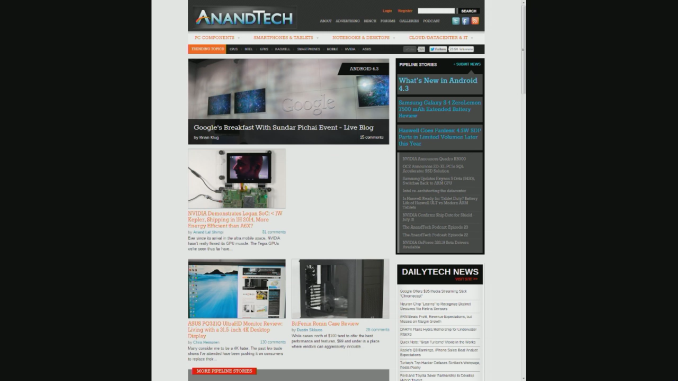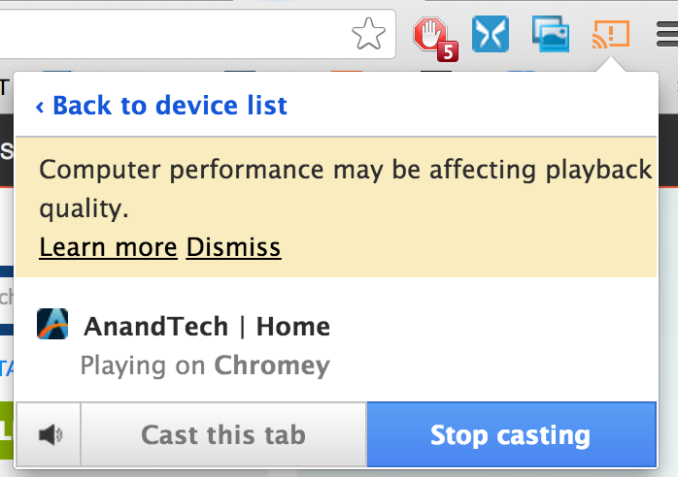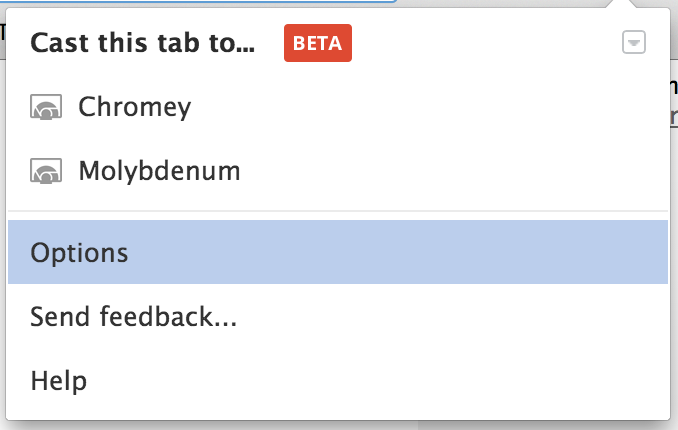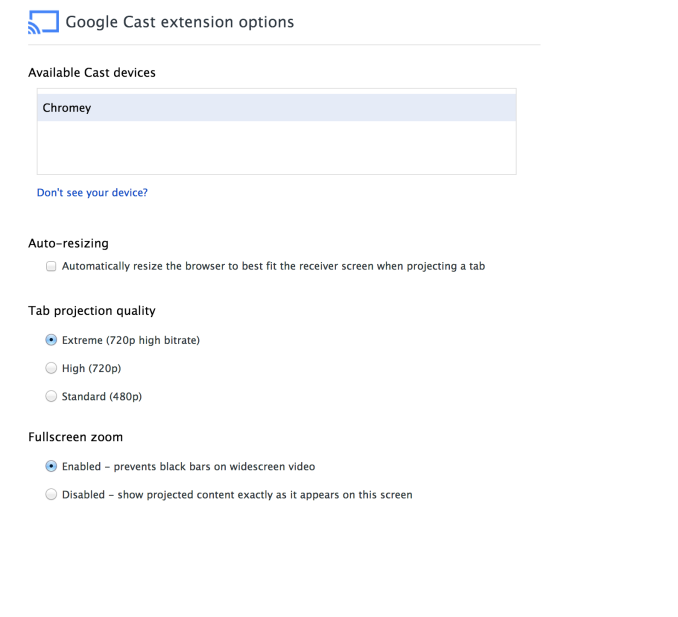Google Chromecast Review - An Awesome $35 HDMI Dongle
by Brian Klug on July 29, 2013 9:45 PM EST- Posted in
- Smartphones
- Media Player
- Android
- Mobile
- HDMI
- Chrome
- Tablets
- Chromecast
Through Chrome
It’s impossible to expect every service to port their frontend to the Cast SDK, and for some services licensing issues might make that very difficult (Hulu, Amazon Prime, Vudu), or imposible, to say nothing about those who face technical restrictions (Flash). For that, there’s the other side of Chromecast, which works similar in practice to other screen mirroring standards (WiDi, Miracast, AirPlay Mirroring), and streams the content of a tab, and its audio, directly to the receiver. The plugin adds a Cast icon to Chrome, and there’s a tiny down arrow at the far right for selecting between current tab, audio mode, and if you’re lucky full screen (I don’t know why some see the full screen option and others don’t, neither my Retina MacBook Pro nor Windows 7 desktops see this option, but I’ve seen others show it).
There are three different options in settings for video quality, and since the video is encoded in software on the host, choosing between them will affect CPU use dramatically. I’ve backed out bitrates for the three settings: 5.0 Mbps for extreme (720p high bitrate), 3.0 Mbps for High (720p), 1.7 Mbps for Standard (480p), all seem to be VP8, especially given the fact that this is essentially WebRTC in practice.
There’s latency of about a second on the connection, and of course the occasional artifact during motion and a dropped frame or two (depending on connection quality), but it works surprisingly well.

HDMI Capture of Chrome Casted Tab
For a lot of services that don’t have Cast support this is the only way to get video across, it’s essentially AirPlay Mirroring but of a tab (or full screen if the setting is visible under that drop down). I’d love to see this functionality added to Chrome for Android or iOS if that’s possible as well, though those platforms really need VP8 hardware encode to make it tenable.













105 Comments
View All Comments
MKBL - Tuesday, July 30, 2013 - link
I'm confused. Right now I have a laptop with broken screen connected to a TV through HDMI. This setup handles most streaming efficiently, and I wonder if Chromecast will replace it with better efficiency. Maybe I'm facing my moment of being a tech-norant at age of 41, but I don't get the concept of the Chromecast. Does it receive all media data through laptop or tablet/smartphone that controls it remotely, or will it be streamed directly to Chromecast, which then decode it once the remote control - selecting channel/source, etc. ? If it is the former case, what is the difference between having a laptop connected and Chromecast connected to TV? I understand that the size is huge difference, and the price as well, but someone like me with extra laptop or media box like Zotac Z-box already, is there any benefit of having Chromecast? I'm not rejecting it, I am just confused.savagemike - Tuesday, July 30, 2013 - link
You will see no benefit.Chromecast uses both methods you describe. For the apps with it built in the controlling device is doing nothing but acting as a control channel. The content is streamed directly from the cloud source by the chromecast device.
For the beta tab-casting feature using a Chrome browser on a computer - the source computer is encoding everything and streaming it to the Chromecast. It is actively mirroring it's content to the Chromecast itself.
To the Chromecast device itself these thing are indistinguishable I imagine.
In any event if Google could hand out laptops with no screens for $35 this would be an even more amazing product.
Wolfpup - Tuesday, July 30, 2013 - link
Dumb question, but AppleTV basically does this same thing, but using OS X or iOS, right? Like Airplay can stream arbitrary content from OS X or iOS? (Though I guess not Windows?)Sm0kes - Tuesday, July 30, 2013 - link
Correct, this looks to compete directly with Airplay. I think the excitement around this stems from the fact that 1.) it's cheaper than anything airplay enabled 2.) and more "open" (as opposed to being locked to a single platform).Obviously, it'll take time for the developers and hackers to really dig in, but it's definitely a promising little device.
steven75 - Monday, August 5, 2013 - link
It does a subset of the things ATV does, since ATV can:-Be used standalone without any other device
-AirPlay local files from device-to-device (pictures/videos/apps)
-Full 1:1 screen mirroring, no browser needed
-Act as AirPlay receiver for multiple streams simultaneously (multi-room A/V)
-More support from content owners: Hulu, HBO Go, MLB/NBA/NHL, etc
Those things are definitely worth the extra $64 to me. YMMV.
matt30 - Tuesday, July 30, 2013 - link
It seems that only the beta channel of Chrome has the option to share your entire desktop. You might want to test that.Also, I don't think the "second mode" as you called it, works purely over LAN. In part I think that's the source of the delay. Try casting a tab then cutting your internet. If I'm right the tab casting should stop despite the fact that there is still a LAN.
Sm0kes - Tuesday, July 30, 2013 - link
Interesting. I can't imagine google would be encoding via the cloud?matt30 - Tuesday, July 30, 2013 - link
I'm sure the content is encoded locally but I suspect something funny might be happening with the routing.savagemike - Tuesday, July 30, 2013 - link
Why do you suspect this if you apparently don't have a unit to test it on?matt30 - Wednesday, July 31, 2013 - link
The latency and use of webRTC to transmit screen information.